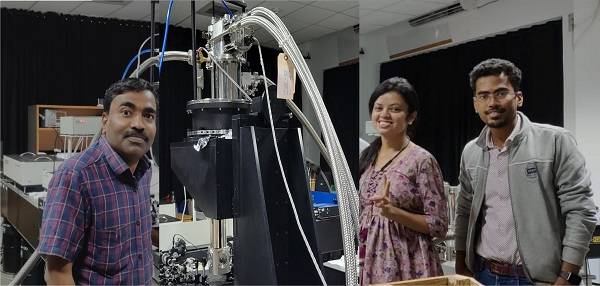
Photo : L_to_R Prof. Adarsh K V, Dr. Megha Shrivastava, and Mr. Santu K. Bera
Bhopal, : Indian Institute of Science Education and Research Bhopal researchers have made a breakthrough in the field of low threshold gain lasers. They have developed a process by which tiny crystals of cesium lead bromide may be manipulated to produce high-intensity lasers with very low energy output.
This development has recently been published in the journal Nano Letters. The research has been led by Prof. K.V. Adarsh, Department of Physics, IISER Bhopal, and co-authored by his Ph.D. scholars Mr. Santu K. Bera and Dr. Megha Shrivastava from IISER Bhopal and Prof. Narayan Pradhan and his student Dr. Suman Bera from Indian Association for the Cultivation of Science, Kolkata.
Lasers are extensively used in many applications today, including telecommunications, lighting, displays, medical diagnostics and therapeutics, biosensing, and neuroscience. Lasers are highly directional, monochromatic, and coherent beams of light that are produced by exciting atoms or molecules in a medium, such as a crystal, gas, or semiconductor, using an external energy source. When the excited atoms or molecules return to their lower energy levels, they emit light, which stimulates other excited atoms or molecules to emit more light – resulting in a highly intense beam of light that we know as lasers.
There is now much interest in the development of low-threshold gain lasers that require very low energy input to produce laser beams. Semiconductor Nanocrystals - tiny crystals that are a thousand times smaller than the width of a single human hair – are being studied as low-threshold gain laser sources.
IISER Bhopal team has been working with nanocrystals of a material called cesium lead bromide. Although this material has a high photoluminescence quantum yield, meaning it emits a lot of light for the energy put in, it suffers from a problem called Auger recombination. This is a phenomenon in which, part of the energy is released as heat instead of converting into light
To overcome this problem, the IISER Bhopal researchers developed a new technique called "facet engineering." This technique involves changing the shape of the nanocrystals to reduce the gain threshold.
Explaining the work, Prof. K.V. Adarsh, IISER Bhopal, said, “By changing the shape of the nanocrystals from a cube (6 faces) to a rhombicuboctahedron (26 faces), we were able to achieve a five-fold reduction in the gain threshold, which could make these nanocrystals much more useful in practical applications.”
The specific mechanism by which facet engineering reduces the rate of Auger recombination is not yet fully understood, but the researchers speculate that it has to do with how the electrons are confined within the crystal. The increase in the number of faces likely reduces the number of places where electrons and holes can recombine thereby avoiding energy dissipation.
This study represents an important step forward in the field of lasers and quantum physics and highlights the potential of facet engineering as a new tool for manipulating the properties of these nano-dimensional materials.
Click Here for More Science & Technology
